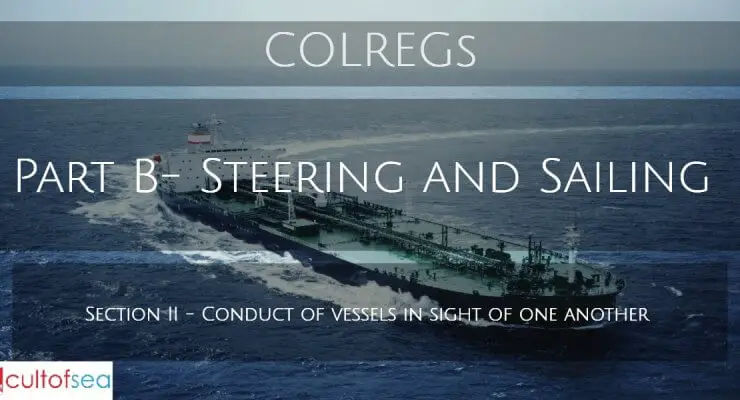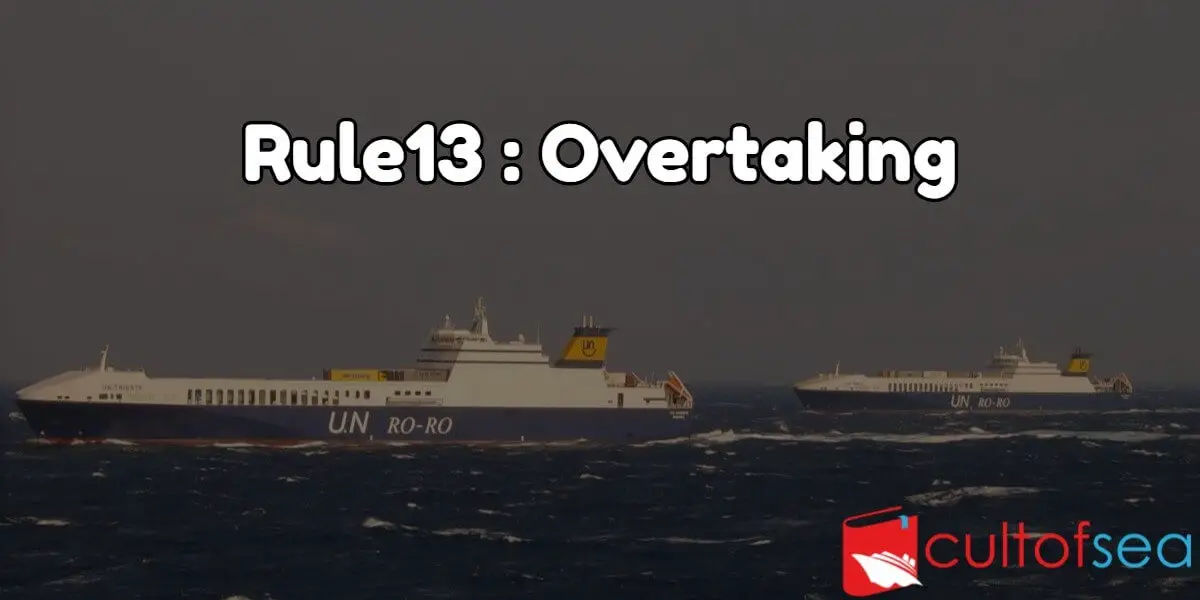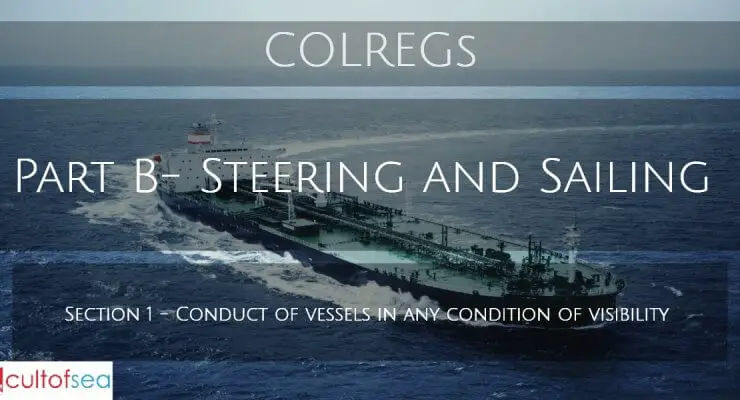Section II – Conduct of vessels in sight of one another Rule 14: Head on situation a. When two power-driven vessels are meeting on reciprocal or nearly reciprocal courses so as to involve risk of collision each shall alter her course to starboard so that each shall pass on the port side of the other.Meaning: It is a clear instruction when the vessels are head on perfectly, the thing to remember is that when the vessels are nearly on reciprocal courses, then to the vessels are asked to alter course to starboard.A nearly reciprocal course would deem that the vessels would be passing … [Read more...]
Archives for October 2015
Rule13 – Overtaking
Section II – Conduct of vessels in sight of one another Rule13 Overtaking a. Notwithstanding anything contained in the Rules of part B, sections I and II, any vessel overtaking any other shall keep out of the way of the vessel being overtaken.Meaning: It does not make a difference whether any ship ahead of the own vessel has permitted by signaling that overtaking may take place. As far as the Rules are concerned especially Rule 13, the overtaking vessel is duty bound to keep clear.b. A vessel shall be deemed to be overtaking when coming up with another vessel from a direction more … [Read more...]
Rule 12 – Sailing vessels
Section II – Conduct of vessels in sight of one another Rule 12: Sailing vessels(a) when two sailing vessels are approaching one another, so as to involve risk of collision, one of them shall keep out of the way of the other as follows: (i) when each of them has the wind on a different side, the vessel which has the wind on the port side shall keep out of the way of the other; (ii) When both have the wind on the same side, the vessel which is to windward shall keep out of the way of the vessel which is to leeward; (iii) if the vessel with the wind on the port side sees a vessel to … [Read more...]
Rule 11 – Application
Section II - Conduct of vessels in sight of one another Rule 11 - Application Rules in this section apply to vessels in sight of one another. … [Read more...]
Rule 10 – Traffic separation schemes
Section 1 — Conduct of Vessels in any Condition of VisibilityRule 10: Traffic separation schemesa. This Rule applies to traffic separation schemes adopted by the Organization and does not relieve any vessel of her obligation under any other Rule.Meaning: The objective of this rule of the COLREGS is that although IMO may enforce traffic separation schemes, but the instructions in this rule shall not go against the rules as stated elsewhere in the COLREGS. So a vessel even when in a TS has to obey the other rules as well as this rule on TS.b. A vessel using a traffic separation … [Read more...]
Rule 9 – Narrow Channels
Section 1 — Conduct of Vessels in any Condition of VisibilityRule 9 : Narrow ChannelsTwo terms are used throughout the Rule that are not defined. They are "narrow channel" (namesake of the Rule) and "(narrow) fairway." We must assume that the drafters of the Rules either believed their meanings to be obvious or else were not able to formulate suitable concise definitions.Rule 9 applies only on waters described by the two terms. What is "narrow" depends on the type of vessel and the circumstances. A "channel" is a natural or dredged lane restricted on either side by shallow water; it is … [Read more...]
Rule 8 – Action to avoid collision
Section 1 — Conduct of Vessels in any Condition of VisibilityRule 8 : Action to avoid collision(a) Any action to avoid collision shall be taken in accordance with the Rules of this Part and shall, if the circumstances of the case admit, be positive, made in ample time and with due regard to the observance of good seamanship.Qualification of the action: The action should be positive meaning that it should result in the reduction of the risk of collision, not aggravate it.Should be made in ample time, implying that the assessment should be done in time and obviously that means … [Read more...]
Rule 7 – Risk of collision
Section 1 — Conduct of Vessels in any Condition of Visibility Rule 7 : Risk of collision a. Every vessel shall use all available means appropriate to the prevailing circumstances arid conditions to determine if risk of collision exists. If there is any doubt such risk shall be deemed to exist.A famous sentence in the Master’s Night Order book was ‘Whenever in doubt, call me’. This holds true with the above Rule. If the watch keeper is in any doubt even the slightest, he should assume that such risk exists and would have to act according to the Rules.Of course in judging such risk, he … [Read more...]
Rule 6 – Safe Speed
Section 1 — Conduct of Vessels in any Condition of Visibility Rule 6: Safe Speed Every vessel shall at all times proceed at a safe speed so that she can take proper and effective action to avoid collision and be stopped within a distance appropriate to the prevailing circumstances and conditions.In determining a safe speed the following factors shall be among those taken into account:-Meaning: A very difficult statement ‘Safe Speed’. Any vessel, which is sailing has some speed and with that, it can cause trouble for others as well as to itself. If the speed is very low and the … [Read more...]
Rule 5 – Lookout
Section 1 — Conduct of Vessels in any Condition of Visibility Rule 5 : Look-out Every vessel shall at all times maintain a proper look-out by sight and hearing as by all available means appropriate in the prevailing circumstances and conditions so as to make a full appraisal of the situation and of the risk of collision.Meaning: Lookout is very important and should take about 70 - 80% of the watch keeping officers time. The rest is to be the full appraisal of what he sees, and the action that is taken by him. Lookout is also for getting the feedback on the action that he or the other … [Read more...]



